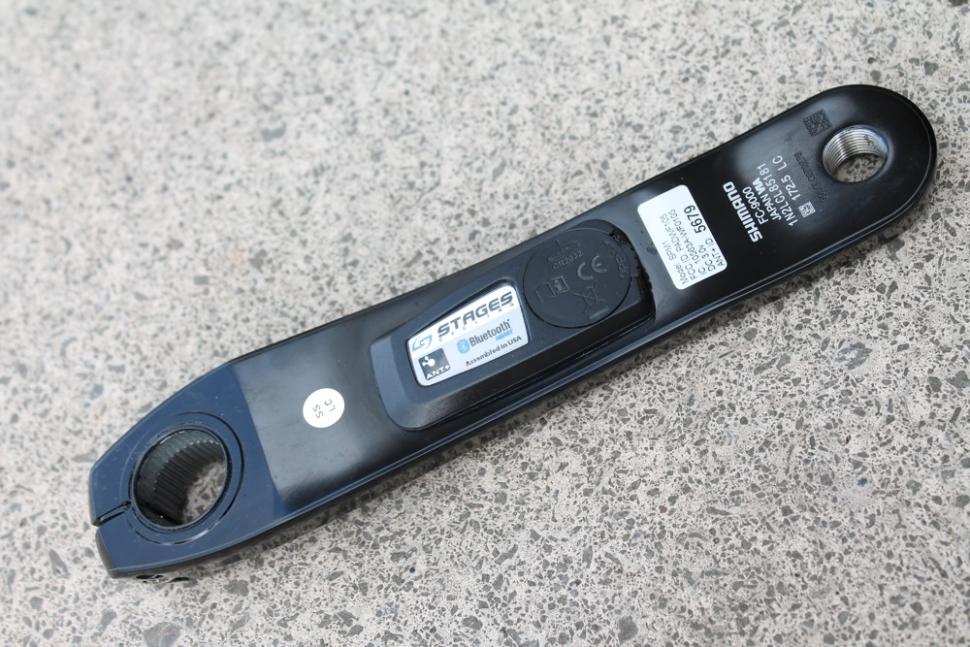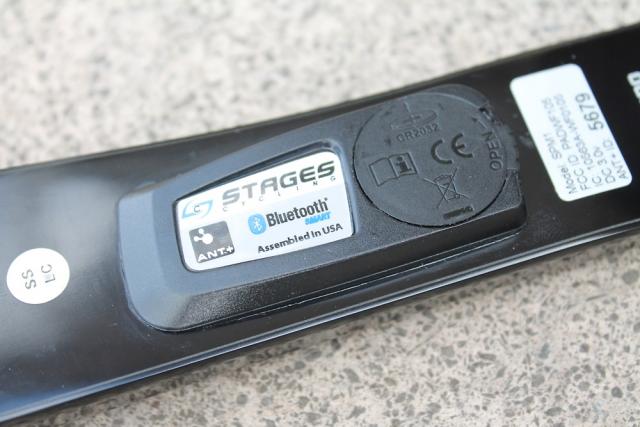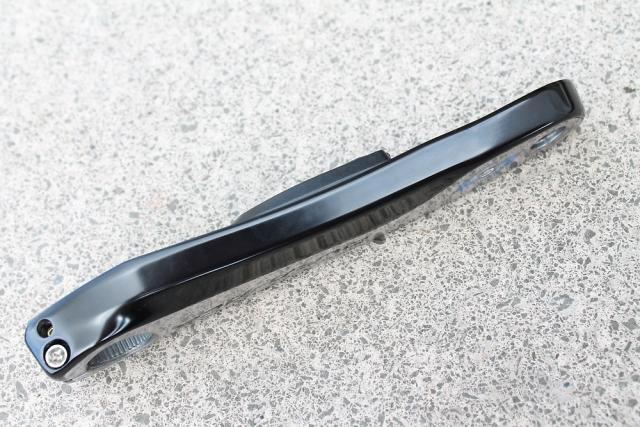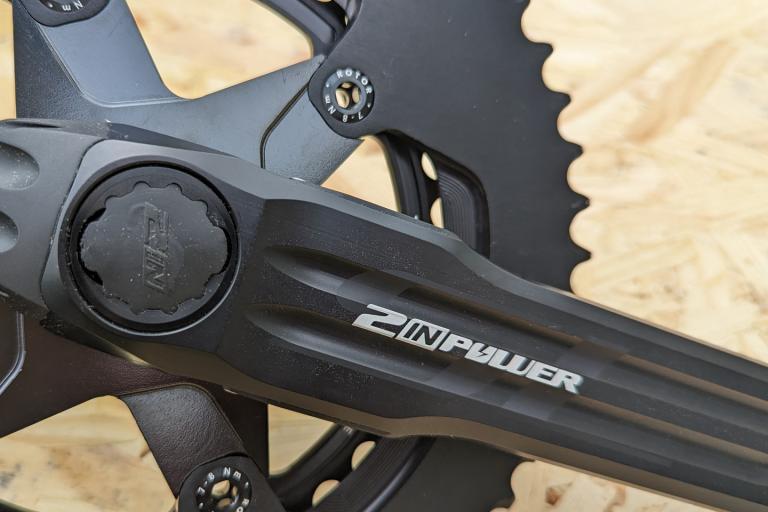- News
- Reviews
- Bikes
- Accessories
- Accessories - misc
- Computer mounts
- Bags
- Bar ends
- Bike bags & cases
- Bottle cages
- Bottles
- Cameras
- Car racks
- Child seats
- Computers
- Glasses
- GPS units
- Helmets
- Lights - front
- Lights - rear
- Lights - sets
- Locks
- Mirrors
- Mudguards
- Racks
- Pumps & CO2 inflators
- Puncture kits
- Reflectives
- Smart watches
- Stands and racks
- Trailers
- Clothing
- Components
- Bar tape & grips
- Bottom brackets
- Brake & gear cables
- Brake & STI levers
- Brake pads & spares
- Brakes
- Cassettes & freewheels
- Chains
- Chainsets & chainrings
- Derailleurs - front
- Derailleurs - rear
- Forks
- Gear levers & shifters
- Groupsets
- Handlebars & extensions
- Headsets
- Hubs
- Inner tubes
- Pedals
- Quick releases & skewers
- Saddles
- Seatposts
- Stems
- Wheels
- Tyres
- Health, fitness and nutrition
- Tools and workshop
- Miscellaneous
- Buyers Guides
- Features
- Forum
- Recommends
- Podcast
review
 Stages Cycling power meter sensor side
Stages Cycling power meter sensor side £799.00
VERDICT:
Lightweight and easy to fit power meter that gives results comparable to much more expensive systems.
Weight:
196g
Contact:
www.saddleback.co.uk
At road.cc every product is thoroughly tested for as long as it takes to get a proper insight into how well it works. Our reviewers are experienced cyclists that we trust to be objective. While we strive to ensure that opinions expressed are backed up by facts, reviews are by their nature an informed opinion, not a definitive verdict. We don't intentionally try to break anything (except locks) but we do try to look for weak points in any design. The overall score is not just an average of the other scores: it reflects both a product's function and value – with value determined by how a product compares with items of similar spec, quality, and price.
What the road.cc scores meanGood scores are more common than bad, because fortunately good products are more common than bad.
- Exceptional
- Excellent
- Very Good
- Good
- Quite good
- Average
- Not so good
- Poor
- Bad
- Appalling
The Stages Power meter is lightweight, easy to fit and, according to our tests, it gives results that are comparable with those of systems costing twice as much.
The Stages Power meter is housed in a left (non-driveside) crank. You buy the complete crank with the power meter already installed. Stages offer various different models starting at £599, but only in alloy cranks. They say that carbon doesn't provide the consistent deflection curve needed for the technology to measure accurately.

There are currently no Campagnolo options and if you want a SRAM version, it has to be Rival (which you can use with a Red driveside crank, for example). We used the Shimano Dura-Ace 9000 version, so Shimano made the crank and Stages added the power meter.
The Stages system relies on a bending beam that is added in a pod on the crank. When you push on the pedals, the crank deflects enough for the bending beam to pick up the movement, accelerometers measure cadence down to 30rpm, and the data is converted into a power reading. The Stages system adjusts automatically for changes in temperature. By power meter standards, the way Stages derive your power figure is relatively straightforward, and they believe this simplicity ultimately leads to accuracy.
The Stages system adds less than 20g to your bike and it runs on an everyday CR2032 coin cell. You get about 200 hours of use per battery, according to Stages.
Fitting and setup
Fitting the Stages Power meter is simple. You take off your left crank and replace it with the one from Stages. The Stages unit protrudes slightly from the inner face of the crank and that means it's not compatible with some bikes with very tight chainstay clearance, but you'll be okay in the vast majority of cases. If you're worried, go to the Stages website and perform the quick check they suggest.
Assuming everything is fine, you tighten your pedals in place. If you want to swap between bikes, it's equally easy as long as you have the same (or a compatible) groupset on the other bike, of course.

You then need to follow your bike computer's instructions for pairing with the powermeter, which is likely to take seconds. A Stages Power meter will work with both ANT+ and Bluetooth Smart units.
At the start of every ride you should 'zero reset' the system to get the most accurate results. You just sling the cranks into the vertical position and follow the zero reset procedure on your computer. With a Garmin, you just hit 'calibrate'. You'll hopefully get a message within a few seconds telling you that it has been successful. It always worked first time for me. Then you're ready to ride.
During the ride
Once out on your ride, the Stages system is so lightweight and unobtrusive that you don't notice it at all, and you don't need to do anything out of the ordinary. Unlike with some systems, there's no need to zero reset while on the road. Even if you head up a big mountain and the temperature plummets, the system updates automatically.

The amount of information you can display varies according to the head unit that you use. I paired the Stages Power meter with a Garmin Edge 510 most of the time, and displayed my average power over the whole ride and the power for the last 30 seconds (to smooth out big peaks and troughs), but there are usually loads of power measurements you can choose to show. You also get a cadence measurement without the need to add anything else to your bike '' no magnet, no sensor.
Results
You have to go to some lengths to get meaningful information in a power meter review. To compare the Stages meter with other power meters I fitted the Stages crank, a PowerTap and Garmin Vector pedals to the same bike, and used three different computers to display and collect the data prior to uploading it. I followed each company's installation and calibration instructions to the letter, and made sure the Garmin Edge computers were all recording and dealing with zero power in the same way. Then I used the Stages Power meter alongside these other systems on every ride for seven weeks: short rides, long rides, steady rides, hard rides, interval sessions, turbo sessions... you name it.
The results from the various setups were never exactly the same, so how do we know which are most accurate? You might get similar results from two of the powermeters with the other disagreeing, but that doesn't mean anything. It's not a democratic process – the outlier might be giving the truest reflection of your actual power.
Plus, ANT+ powermeters send out four 'data packets' of information per second and the Garmin computer head units pick up only one of these packets (that's a whole discussion in itself; let's not go into depth here). Run two computers picking up information from the same powermeter and they won't necessarily give you exactly the same results because they'll pick up different data packets. You can get really geeky about this stuff if you want; it's never ending. SRM's PowerControl head unit grabs all data packets sent by the sensor, for example. Using Bluetooth and an app, you can grab all data packets sent by the Stages Power meter.
We can't tell you for sure which powermeter is the most accurate, then. Sorry, but it's just not possible. What we can tell you is that Stages reckon their system is accurate to within +/-2% when you're riding at 100W and 90rpm – so in that scenario you'll get a reading somewhere from 98 watts to 102 watts. They say that the 4 watt range stays the same as you put in more power, so the system gets more accurate in percentage terms.
Looking at our results, the Stages system gave us figures that were within 10 watts of those from our PowerTap most of the time, and within about the same from the results from the Vector system, sometimes a little higher during high-intensity bursts. The averages over the course of a ride were always within 5 watts. These differences easily fall within the operating tolerances given by the manufacturers for each of the systems.
What is perhaps more important than the absolute figures is that the three systems tracked one another impressively consistently – not completely consistently, but always within those operating tolerances. Whether the power you put in is given a figure of 250 watts or 255 watts probably isn't that important to you, it's the fact that the figures you get are consistent that's more valuable and, for us at least, they were.
There was the odd anomaly when the figures from one system would spike or drop relative to the figures from the other two, but nothing that would affect the overall results. The only time figures would stray beyond the bounds explainable by the operating tolerances was an occasional seemingly random high power figure – but that's nothing in the overall scheme of things.
One criticism levelled at the Stages system is that it measures power just through the left crank and doubles it, effectively assuming that you're doing an equal amount of work with each leg.
How much of an assumption is that to make? It's hard to say. The biggest discrepancy the Garmin Vector pedal system has given me in left/right balance over the past couple of months has been 48%/52% but – and this is a crucial point – Garmin say their system is accurate to within +/-2% (they don't say in what circumstances) so there's some wiggle room in those figures.
Even if you did have a significant discrepancy in leg strength, as long as it's consistent within a ride and from one ride to the next, the results you get from a Stages Power meter would still be consistent, and that's the most important thing.
You could get lost forever in the maths and the theory but Stages reckon that their left leg force measurement is more accurate than anything else on the market (including SRM) due to them looking at the force input as simply as possible through the single beam in the crank arm.
They also think that their assumption of symmetry is justified in the vast majority of cases, giving figures that fall within their published system tolerances, and that their use of their calibrated temperature compensation system adds to the overall accuracy.
There's nothing in the data we've collected over the past few weeks that makes us think that the results from Stages fall outside of those claimed system tolerances and for that reason, along with the price and the ease of use, we'd wholeheartedly recommend it.
Verdict
Lightweight and easy to fit power meter that gives results comparable to much more expensive systems.
road.cc test report
Make and model: Stages Power meter
Size tested: 172.5mm
Tell us what the product is for, and who it's aimed at. What do the manufacturers say about it? How does that compare to your own feelings about it?
Lots of people have the idea that power meters are only for hardcore racers. Serious athletes will certainly get a lot out of the Stages system, but so will anyone else who wants to maximise the physiological benefit they can get from their time on the bike.
Rate the product for quality of construction:
8/10
Stages just take an existing crank from the relevant manufacturer, make a hole and add their device in there.
Rate the product for performance:
9/10
Hidden away in a hollow in the inner face of the crank, you'd have to be pretty careless or very unlucky to damage it. I guess you could damage the left crank in a crash to the point that it's no longer useable '' but you could say that about any component.
Rate the product for weight, if applicable:
10/10
It adds 20g to an existing crank. That's really not worth worrying about
Rate the product for value:
10/10
Prices start at £599. In this market, that's cheap.
Tell us what you particularly liked about the product
Lightweight, easy to setup, easy to use, difficult to damage, gives results comparable to those of far more expensive systems.
Tell us what you particularly disliked about the product
Um... All other things being equal, I guess I'd like info on left/right leg balance, but I'm struggling to pick faults here.
Did you enjoy using the product? Yes.
Would you consider buying the product? Definitely.
Would you recommend the product to a friend? Definitely.
About the tester
Age: 43 Height: 190cm Weight: 75kg
I usually ride: My best bike is:
I've been riding for: Over 20 years I ride: Most days I would class myself as: Expert
I regularly do the following types of riding: commuting, club rides, sportives, general fitness riding,
Mat has been in cycling media since 1996, on titles including BikeRadar, Total Bike, Total Mountain Bike, What Mountain Bike and Mountain Biking UK, and he has been editor of 220 Triathlon and Cycling Plus. Mat has been road.cc technical editor for over a decade, testing bikes, fettling the latest kit, and trying out the most up-to-the-minute clothing. We send him off around the world to get all the news from launches and shows too. He has won his category in Ironman UK 70.3 and finished on the podium in both marathons he has run. Mat is a Cambridge graduate who did a post-grad in magazine journalism, and he is a winner of the Cycling Media Award for Specialist Online Writer. Now over 50, he's riding road and gravel bikes most days for fun and fitness rather than training for competitions.
Latest Comments
- ktache 3 hours 28 min ago
The small frame, the aggressive posture, lots of standover height.
- mctrials23 4 hours 24 min ago
As i've said before, the police should be sued for a lot of money when someone they have knowingly ignored has gone on to commit a serious crime....
- David9694 4 hours 31 min ago
'Bad parking' blocks firefighters multiple times on same emergency call-out...
- David9694 4 hours 35 min ago
Cambridgeshire boy, 13, crashes Audi into garden wall after taking it from home...
- Adam Sutton 5 hours 21 min ago
Good stuff. Now do it on cycleway C9 through Hammersmith to Chiswick.
- mark1a 5 hours 30 min ago
It's technically allowed but it's not known as "London's Orbital Car Park" for nothing.
- Dogless 6 hours 38 min ago
You're defending bombing hospitals and refugee camps and starving children.
- mattw 9 hours 18 min ago
Used car salesman is a complete attention-seeking plank....
- tubasti 9 hours 35 min ago
I don't know if they're any better, but they's certainly become more boring.
- FionaJJ 10 hours 1 min ago
At risk of being cynical, and stereotyping the police, it's so they don't have to leave the comfort of their panda cars and pursue on foot when...




Add new comment
24 comments